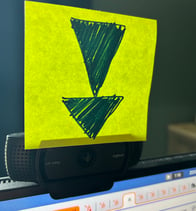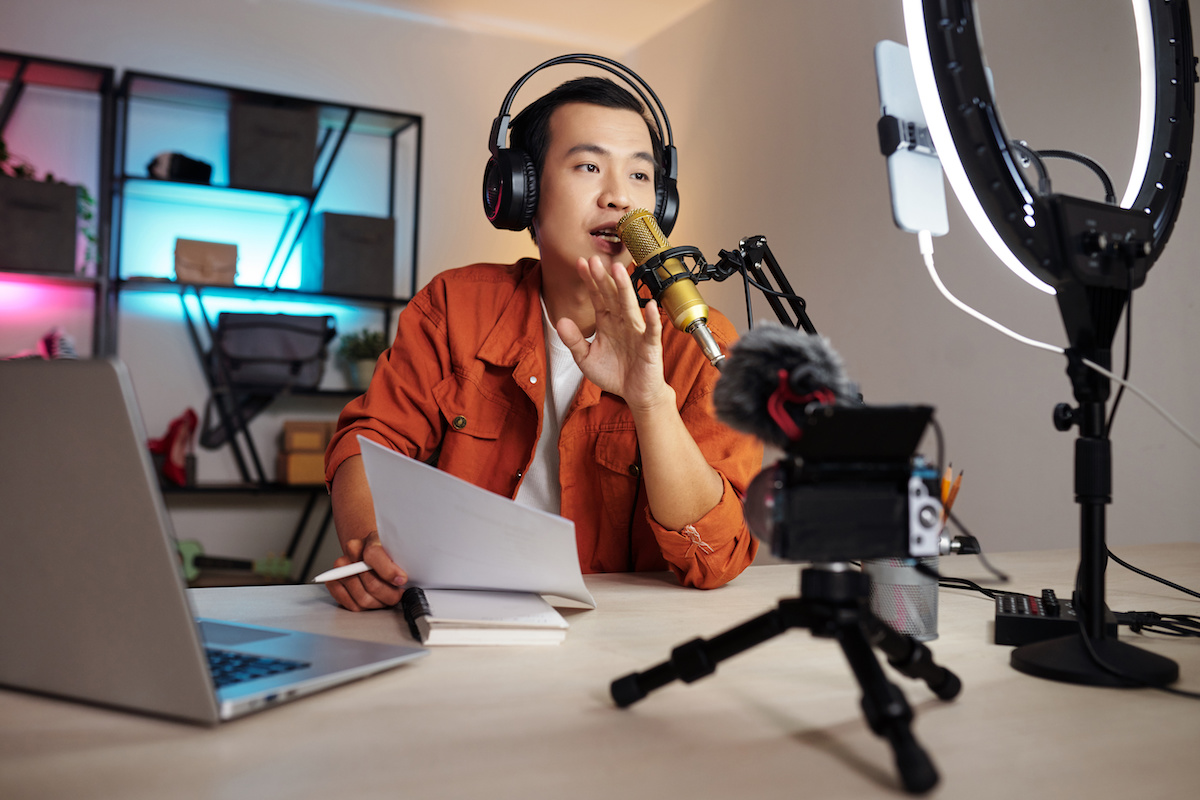Recording a video can feel a little odd, especially if you’re not used to it. As more and more video content is created, we have a few tips for you to keep in mind as you prepare. These are great for people who are video-recording for podcasts, “how to” videos and even webinars or web meetings that will be recorded.
Let’s take a look at a few areas you should consider before you shoot your video.
- Where to record
- How to set up for a good recording session
- What to wear
- What to think about while recording.
Room Choice. Where Are You Going to Record?
If you’ve ever worked from home you know there are some spaces that are more conducive to web calls than other areas of your home. The same is true for offices. You are going to need a room that is:
- Quiet. We know there can be some noise outside of the room that you can’t control. But if you know you can hear people as they walk down the hallway even with the door closed, that might interfere with your recording and your concentration. Try to find a spot that’s not in the heart of the activity in your workplace.
- Doesn’t echo. Try to avoid rooms that are empty or have hard floors and tall ceilings. This will cause your voice to echo a bit and that can be heard in the video.
- Has natural light. If possible try to place yourself in a room that has a window in front of you. You’ll still need a light source that’s closer to your face, but natural light in front of you is a good idea. Avoid natural light behind you. That will cause you to be backlit which means your face can’t be seen.
- Assess the space behind you. Look at the wall that will be behind you while you’re recording. For most podcast software, you won’t be able to blur the background behind you, so have a look at what’s back there. Is it neat, orderly, not overly busy but also not just a blank wall?
Also, consider whether you’ll be sitting or standing when you record. Then, get yourself into a position so that you know what the space looks like behind you when you’re sitting, or standing. - Choose a chair that doesn't squeak. If you’re going to be sitting, think about the chair you’ll use. As you set up your table or desk where the recording will take place, choose a chair that doesn’t squeak. If possible, choose a chair that doesn’t swivel either. It’s easy to move more in the video when you have a swivel chair and that can be distracting.
Setting Up Your Recording Space
- Camera placement. Pretend you’re talking to a friend. It would be odd if the person looked just under your face during the whole conversation, right? That’s why it’s also odd when people in videos don’t look AT the camera.
It should be eye level with you in whatever position you’ll be in during recording. Too high and everyone will be looking at the top of your head. And too low causes a nostril shot that you probably won’t find flattering.
Find a sturdy surface. You need this for your computer and camera, such as a desk, but not your lap. If you’re using a laptop camera and don’t have a computer stand to bring it up to eye height, choose some books or something sturdy that will hold the computer steady.
If you have a separate camera connected to the computer, it’s a good idea to use a small tripod to keep it eye level and stable. - Where to place your computer screen. Hopefully you’re not reading things from a screen. But, if you’re sharing your screen and need to look at it, be sure you come back to looking at the camera now and then. This is how you will connect with your viewer.
Place your computer screen right under the camera and not way off to the left or right. I like to put a post-it or something else bright and easy to see near the camera so you remember to look there during the recording rather than at your screen. - Lights and mic. If you have lights that will be used, it’s best to put them next to the computer screen. Test it out and make sure your face is evenly lit so you aren’t seeing a lot of shadows under your eyes or on a side of your face.
Your microphone should be close to you but out of the screen if you’re using a separate device.
Take a moment to check yourself when you’re doing setup
Start the tool you will use for recording your video. If that’s a podcast tool like Riverside or Descript. Or if it’s Zoom, whatever you’re using, turn it on and look at yourself in the camera. Do a mic check. How does the lighting look? Are you in the center of the frame? Are you too close to the camera or too far away? If there are two of you in the recording, side by side, try to take about the same amount of space in the frame.
What to Wear When on Camera
This seems trivial, but it matters. Solid colors are a sure bet. Small patterns like checks, tiny plaid or polka dots can look funny on the screen. This includes shirts, jackets and neckties. But no matter what you choose, try not to blend in with the colors behind you. Pick a contrasting color that will help you stand out. You might bring a few options to try, just in case.
Also, if you wear accessories, try to avoid things that make noise like charm bracelets, or multiple bangle bracelets. That noise will pick up on camera and is hard to cancel out.
Things to Think About When Recording Your Video
You’re ready for your recording. You’re sitting in front of the camera. What do you need to think about now?
 Where to look. I know we’ve already said this, but one more time: LOOK AT THE CAMERA. Remember your screen and any image of yourself on the screen is not the camera. That’s why we recommend placing something bright just above the camera so you remember to look there. If you’re sharing a screen or giving a presentation you’ll have to look down at what you’re doing. Just don’t forget to come back to the camera and don’t stare at the screen (which is NOT your camera) the whole time.
Where to look. I know we’ve already said this, but one more time: LOOK AT THE CAMERA. Remember your screen and any image of yourself on the screen is not the camera. That’s why we recommend placing something bright just above the camera so you remember to look there. If you’re sharing a screen or giving a presentation you’ll have to look down at what you’re doing. Just don’t forget to come back to the camera and don’t stare at the screen (which is NOT your camera) the whole time. - Let your co-workers or family members know you’re recording. Let those who share space with you know when you’ll be recording and for about how long. While some background noise can be eliminated, not all of it can. And if someone walks into the room there’s a chance it can’t be edited out. Place a reminder sign on the door of the room you’re in so that hopefully they’ll pause before walking in.
- Find your spot and stick to it. We talked about framing yourself in the shot. Once you’ve found the spot, try not to move out of it.
- Stay centered in the shot
- Don’t slouch down
- Don’t sit forward so you’re too close to the camera.
- Don’t push away from the camera either. It will change your appearance in the video.
- Minimize movement. You don’t need to be stiff or robotic, but big motions don’t come across well on camera. If you’re a hand-talker, try to keep them low and move only a little. Otherwise it gets distracting. One trick I use is to hold my hands together about diaphragm level. This keeps me from waving them around too much during a video.
You also wouldn’t want to move around papers on the desk or table where you’re sitting. The mic will pick that up. As well as clicking pens or tapping fingers.
- Put your phone away. If possible, don’t have phones in the same room. Even a vibrating phone can be picked up in the video. If you have an office phone that uses a “pager” system, be sure that’s muted as well.
- Consider the right tone for your recording. If you’re recording a podcast and not a formal presentation, remember that you shouldn’t need a lot of notes. You’re going to be having a conversation on a topic you’re highly familiar with. That’s why you’re on the podcast! It’s a good idea to be prepared with some notes that you leave on the screen. But try not to be tied to them. Just have a conversation.
Now You’re Ready for an Incredible Video Recording Session
You might feel a little weird at first, but it gets easier with time. Just talk to the camera like it’s your best friend and you’re telling them a story! Your recording will come across sincere and authentic.
Good luck and happy recording!
Topics:
VideoFebruary 24, 2023


